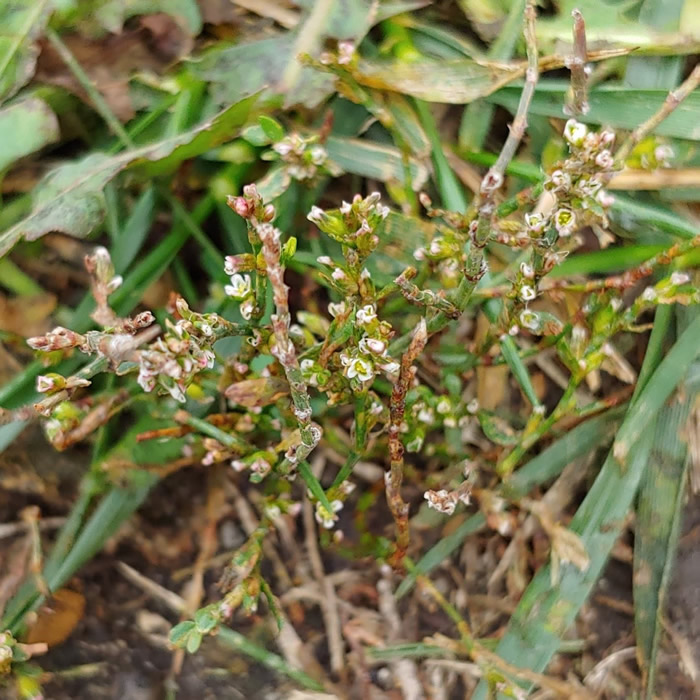Issue 14, October 30, 2019
Prostrate Knotweed - HYG - 2019
Prostrate knotweed (Polygonum aviculare) is a warm season (summer) annual that has been prevalent this summer with the dry conditions. To the untrained eye, it may go unnoticed. However, with colder conditions, this plant takes on a purplish color. The blooms are tiny but they are easily visible at this time too if one stops to look. The flowers are borne in small clusters in leaf axils from June through October but typically go unnoticed due to their small size. The sepals are white to green, with pinkish margins. Seeds then follow which is how the plant reproduces.

Prostrate knotweed flowers.
It germinates very early in the spring, typically late February to early March, and first appears when soil temperatures are only in the 40’s. The seed leaves (cotyledons) are very narrow and grass-like in appearance, earning it the nickname Knotgrass. With time, seedlings will grow into a circular mat. Stems can extend up to 2 feet long. They are wiry and tough to pull apart especially if the plant has been growing in droughty conditions. The leaves are dull, blue-green, alternate on the stem, long and narrow (up to 1¼ inch long and 1/3 inch wide). The leaves can appear grayish-green or whitish green when infected with mildew fungi. Being a member of the Buckwheat family, it has a papery sheath (ocrea) surrounding the stem at the leaf base. Prostrate spurge is similar in appearance and in growth habit, however, it has oppositely arranged leaves and the stems exude a milky sap when damaged.

Prostrate knotweed seedlings.
An indicator of compacted soils, prostrate knotweed is often found growing in full sun in thin turf or next to sidewalks and driveways where traffic has spilled over. If not for this weed, bare soil would result in many of these areas.

Prostrate knotweed growing in a landscape bed.
Prostrate knotweed has a thin taproot so hand removal is an option, but best used on young plants growing in moist soil. Tillage can be used and for turfgrass situations, core aerification can be used to get more oxygen to the roots which can aid in growth of grass. Prostrate knotweed tolerates low oxygen levels in the soil.
Postemergent herbicides for controlling this weed in cool season turf include 2,4-D, dicamba, and triclopyr. 2,4-D is best used in combination with others. Preemergent options include dithiopyr, isoxaben, pendimethalin and prodiamine. Isoxaben has been rated as excellent in research trials. Due to the early arrival of prostrate knotweed, late fall preemergent applications are often used. For landscapes, these additional herbicides may be used: dichlobenil, napropamide, oryzalin, and trifluralin. The lists provided here are for reference only and may not be all-inclusive. For more information about these herbicides, consult with the Commercial Landscape & Turfgrass Pest Management Handbook. Remember to carefully read and follow all pesticide label directions.
Author:
Michelle Wiesbrook